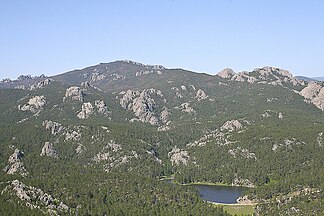Black Hills
| Black Hills | ||
|---|---|---|
|
View of the northeast side of Black Elk Peak, |
||
| Highest peak | Black Elk Peak ( 2208 m ) | |
| location | South Dakota , Wyoming (USA) | |
|
|
||
| Coordinates | 44 ° 0 ′ N , 104 ° 0 ′ W | |
The Black Hills ( German Black Mountains , Lakota Paha Sapa or He Sapa ) are a mountain range in the west of the US state of South Dakota that extends into northeastern Wyoming . It is isolated in the eastern foreland of the Rocky Mountains on the western edge of the Great Plains and has fauna and flora that differ from the surrounding area. For example, a subspecies of Junko occurs only here and coastal pines , white spruces and flexible pines can be found in the forests . Due to the dense coniferous forest, bird species such as the pine jay , the crossbill and the Indian gold cockerel are at home here.
The Black Hills extend between 43 ° 30 'and 45 ° north latitude and 103 ° and 105 ° west longitude. The almost elliptical mountain range in the map is about 160 km long and up to 96 km wide. Its longitudinal axis runs in a north-south direction. The base of the Black Hills is 760 to 900 m above sea level. The highest point is the Black Elk Peak at 2,208 m in the south of the mountain.
Significant gold deposits were discovered in the Black Hills in the 19th century . Also, lead , iron , uranium , and salt , oil and coal are found in the Black Hills or in its surrounding area.
history
The Black Hills are sacred mountains for the Lakota -Sioux . They are also the subject of numerous Lakota myths. Even today, some tribesmen visit the spiritual places in the mountains to practice their religion. In the Treaty of Fort Laramie in 1868 by the US government with the Lakota, Cheyenne and Arapaho - Indians completed, the three nations were the Sioux Reserve awarded and the Black Hills promised the Lakota as an exclusive hunting ground. An expedition under George Armstrong Custer, illegal under the Treaty, explored the Black Hills in 1874 and found gold in the mountains . After the gold was discovered, the government tried to persuade the Lakota to cede the mountain range, but without success. Gold prospectors illegally entered the area and a gold rush developed . Conflicts in the winter of 1875/76 led to the renewed deployment of Custers and the 7th Cavalry Regiment and the Battle of Little Bighorn in June 1876. After the final defeat of the Indians in the autumn of the same year, the great Sioux reservation was smashed in 1877 and the Lakota the Black Hills withdrawn.
A process of Lakota in 1921 lasted until 1980, when the Supreme Court in its decision in United States v. Sioux Nation of Indians , 448 US 371 (1980) classified the measure as expropriation and awarded the Lakota $ 105 million in compensation. Although the Lakota Reservation is one of the poorest regions in the United States, the People's Representation did not accept the payment, but continues to demand that the mountains be returned to this day. The funds had grown to over $ 750 million by 2007 through interest.
A bill by Senator Bill Bradley ( D ; NJ ) from the mid-1980s wanted to award the Lakota a round sixth of the mountains that remained federally owned. It failed in the run-up to the formal procedure due to different ideas on the part of the Lakota.
tourism
The most famous tourist attraction in the Black Hills are the four huge stone presidential heads of the Mount Rushmore National Memorial east of Black Elk Peak. A similar project, the Crazy Horse Memorial , is emerging on the other side of Black Elk Peak. Both projects drew the discontent of the Lakota, as they desecrate the Black Hills, sacred to them.
Custer State Park , in which bighorn sheep have been successfully resettled, and two cave systems of outstanding importance, the Wind Cave National Park and the Jewel Cave National Monument, are also located in the Black Hills . In the region around these caves were once again successfully Wapiti introduced which were temporarily wiped out by European settlers. The monolith Devils Tower National Monument is located in the northwest of the mountains. Most of the federally owned mountains are largely designated as Black Hills National Forest , a national forest .
The place Custer was the first gold rush settlement in the Black Hills. The town of Deadwood is the location of the HBO TV series of the same name .
Sturgis is known for the annual Sturgis Motorcycle Rally , which is one of the largest motorcycle events in the world with around half a million visitors.
literature
- Peter Schwarzbauer: The Lakota Report. A people is fighting to survive. Publisher for American Studies , Wyk auf Föhr 1994 (4th edition), ISBN 3-92469608-X .
Web links
Individual evidence
- ↑ paha means hill, he means mountain, sapa means black
- ^ Paul A. Johnsgard: Great Wildlife of the Great Plains . University Press of Kansas, 2003, ISBN 0-7006-1224-6 , p. 137
- ↑ UNITED STATES v. SIOUX NATION OF INDIANS, 448 US 371 (1980) - findlaw.com
- ↑ Frank Pommersheim: Broken Landscape: Indians, Indian Tribes, and the Constitution . Oxford University Press, 2009, ISBN 9780195373066 , p. 75
- ↑ a b Tim Giago: The Black Hills: A Case of Dishonest Dealings . Huffington Post, June 3, 2007
- ^ Paul A. Johnsgard: Great Wildlife of the Great Plains . University Press of Kansas, 2003, ISBN 0-7006-1224-6 , p. 137



